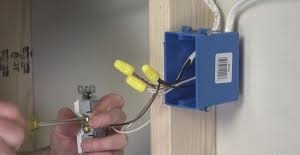Electrical Outlet
Electrical outlets (also known as outlets, electrical sockets, plugs, and wall plugs) allow electrical equipment to connect to the electrical grid. The electrical grid provides alternating current to the outlet. There are two primary types of outlets: domestic and industrial. While not obvious from looking at them, the two sides of an electrical outlet represent part of a ‘loop of wire’ and plugging an electrical device into that outlet completes that loop, which allows electricity to flow through the device so it can operate

How an Electric Outlet Works
In order for electricity to work, it needs to create a circuit. An electrical outlet is the source of electrical power you use to plug in many of your appliances, which is how you create that circuit in your home. Here is how an electrical outlet works:
First, electricity is brought to your home by a power plant and power lines. This power is brought into your home and is distributed by a circuit breaker.
The circuit breaker is connected to each of your outlets by wiring.
An outlet has three holes. The first hole, or left hole, is called “neutral”. The second hole, or right hole, is called “hot”. The third hole is the ground hole. The hot hole is connected to the wire that supplies the electrical current. The neutral hole is connected to the wire that brings the electrical current back to the breaker box. When you plug in a lamp and turn it on, the hot part of the outlet allows electricity to flow into the lamp, turning on the light bulb. The circuit is completed when the current is brought back into the outlet through the neutral slot, and back into the circuit breaker. When you unplug the lamp the circuit is broken and thus the lamp doesn’t work.
A circuit breaker is one level of protection in a home. It’s called a circuit breaker because it will “trip” or “break” a circuit (stop electric current from flowing) if the electric current is too high. Another level of safety for your home’s electrical system is having a grounded wire and grounded outlets.

How to Replace an Electrical Outlet.
Materials
- New electrical outlet
Tools
- Wire strippers or scissors
- Screwdriver
Instructions
- Turn power to the outlet OFF.
- Remove the face plate.
- Unscrew and pull out the old outlet.
- Remove wires from the old outlet.
- Attach new outlet. White wire to silver, black wire to brass, Ground wire to grounding screw at back of box and then to green screw on outlet.
- Gently push the outlet back into the box.
- Screw the new outlet in place.
- Attach new face plate.
- Turn power back on and bask in the glow.

Where to get power
When you’re choosing which circuit to add on to, the ease of pulling the wire to the new receptacle will likely be the most important factor. Here are some acceptable options.
DO add on to these circuits:
- General-purpose receptacle circuits in living areas, attics and unfinished basements.
- Light switch and light fixture locations where un-switched 120-volt power is available.
- Smoke detector locations.
You can’t add on to just any circuit in your house. Here are some circuits you definitely want to avoid.
DON’T add on to these circuits:
- Dedicated kitchen, bathroom and laundry circuits.
- Individual circuits for motor-operated appliances like garbage disposers, refrigerators, furnaces, dishwashers and trash compactors.
- Circuits for specialty appliances like microwave ovens.
- A box with too many wires.
You can use an electrical outlet when:
- If a switch or outlet is on a circuit that often blows its breaker or fuse, don’t make matters worse by adding yet another outlet to the circuit.
- Electrical codes restrict the number of lights or electrical outlets that can be connected to one circuit. Typically, you can have no more than eight lights or electrical outlets on a 15-amp circuit. To determine the amp rating of a circuit, just look at the number on its breaker or fuse in your main electrical panel. Turn off the circuit and test light switches and other outlets to determine exactly which lights or outlets are on a given circuit.
- Most electrical codes now require outlets in kitchens and bathrooms to be on separate 20-amp GFCI circuits. So before using the method we show here for how to wire a wall outlet in a kitchen or bathroom, check with an electrical inspector. If you add an outlet to a kitchen or bath, it must be GFCI protected. Don’t power your new outlet from a kitchen or bathroom outlet.
- Codes also limit the number of wires that can enter an electrical box or electrical receptacle, depending on the inside volume of the box and the gauge of the wires. The outlet-addition methods we show here are based on the most common wiring (14-gauge wire on a 15-amp circuit) and an 18-cu.-in. box (typical inside dimensions are about 2 in. x 3-1/4 in. x 3 in. deep). If the circuit is 20-amp—which means thicker, 12-gauge wire—or if the existing box is smaller than 18 cu. in., you can’t wire a new wall outlet as we show here unless you replace the existing box with a larger one. Plastic box sizes are stamped on the inside at the back.